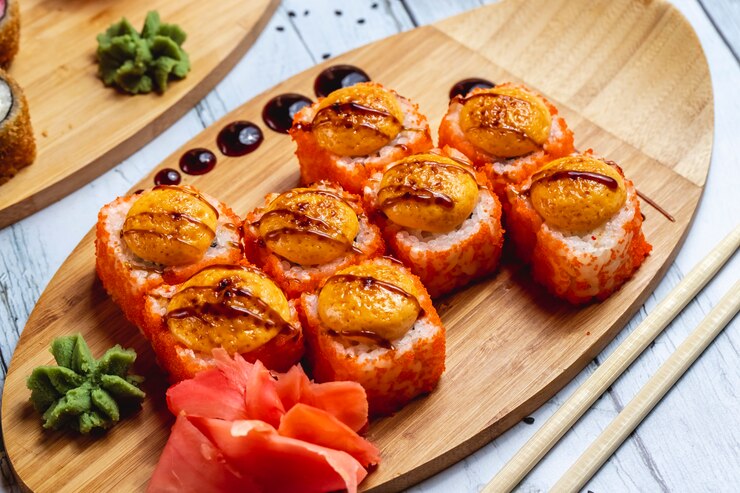Tobiko, also known as flying fish roe, is a traditional Japanese food commonly used as a topping for sushi and other dishes. While it offers some potential health benefits, it’s crucial to be mindful of its limitations and potential drawbacks.
What is Tobiko Food?
Tobiko is a type of fish roe, or fish eggs, popular in Japanese cuisine. It is harvested from flying fish and has a small, bright orange color and a slightly crunchy texture. Tobiko is often used as a topping for sushi and other Japanese dishes, and it can also be enjoyed on its own.
How is Tobiko Made?
Flying fish are caught in the Pacific and Atlantic Oceans. The eggs are then removed from the fish and cured in a salt brine. This process preserves the eggs and gives them their characteristic flavor and texture. After curing, the tobiko is packaged and shipped to markets around the world.
What Does Tobiko Taste Like?

Tobiko has a mild, slightly salty flavor with a hint of smokiness. It is not as strong-flavored as some other types of roe, such as caviar, but it adds a nice pop of flavor and texture to sushi and other dishes.
Where Can I Find Tobiko?
Tobiko can be found at most Japanese grocery stores and online retailers. It is usually sold in small tubs or jars.
How to Use Tobiko
Tobiko is most commonly used as a topping for sushi. It can also be used to garnish other Japanese dishes, such as sashimi, donburi, and salads. Tobiko can also be enjoyed on its own as a snack.
Here are some tips for using tobiko:
- When using tobiko as a topping, spread it out evenly so that each bite gets a little flavor.
- Tobiko can be used fresh or frozen. If you are using frozen tobiko, be sure to thaw it completely before using it.
- Tobiko can be stored in the refrigerator for up to 2 weeks.
Nutritional Value of Tobiko

Tobiko is a good source of protein and omega-3 fatty acids. It is also low in calories and fat.
One serving of tobiko (about 1 tablespoon) contains:
- Calories: 30
- Protein: 3 grams
- Fat: 2 grams
- Omega-3 fatty acids: 0.5 grams
Health Benefits of Tobiko
The omega-3 fatty acids in Tobiko may help to reduce the risk of heart disease, stroke, and cancer. They may also help to improve cognitive function and reduce inflammation.
Is Tobiko Safe to Eat?
Tobiko is generally safe to eat for most people. However, people who are allergic to fish should avoid it. Pregnant women and women who are breastfeeding should also talk to their doctor before eating tobiko, as there is some concern that it may contain mercury.
Health Benefits of Tobiko in 2024

Here’s a balanced and informative approach to exploring the health aspects of tobiko:
Nutritional Profile
- Tobiko is a good source of protein, containing around 3 grams per ounce. Protein is essential for building and repairing tissues, as well as supporting various bodily functions.
- It’s also rich in omega-3 fatty acids, particularly for the eicosapentaenoic and docosahexaenoic acids. These fatty acids play a crucial role in heart health, brain function, and inflammation reduction.
- Tobiko provides some vitamins and minerals, including vitamin B12, selenium, and phosphorus. However, the amounts are generally modest.
Potential Health Benefits
- Heart Health: The omega-3 fatty acids in Tobiko may improve heart health by lowering blood pressure, reducing triglycerides, and decreasing the risk of blood clots.
- Brain Function: Omega-3s also play a vital role in brain development and function, potentially aiding in memory, learning, and cognitive performance.
- Inflammation: Tobiko’s omega-3s may help reduce inflammation throughout the body, potentially benefiting conditions like arthritis and inflammatory bowel disease.
Limitations and Considerations
- Mercury Content: Flying fish, like other large fish, can accumulate mercury in their tissues. While the mercury content in Tobiko is generally considered low, it’s important to be mindful of this, especially for pregnant women, young children, and individuals with certain health conditions.
- Sodium Content: Tobiko is often high in sodium, with around 200mg per ounce. This can be a concern for individuals with high blood pressure or those on sodium-restricted diets.
- Sustainability: Overfishing of flying fish can pose a threat to the sustainability of these populations. Opting for tobiko from sustainable sources is crucial.
Conclusion

Tobiko can be a part of a healthy diet when consumed in moderation and as part of a balanced eating pattern. However, it’s essential to be aware of its limitations, such as mercury content and sodium levels, and to prioritize sustainable sources. If you have any concerns about incorporating tobiko into your diet, consult a healthcare professional for personalized guidance.
Remember, moderation and a balanced approach are key to reaping the potential benefits of any food while minimizing potential drawbacks.
Additional:
- What Is Kumquat? How To Eat It?
- Top 5 Best Theragun Massage Guns
- What Is Waist Trainer? What Are Some Best Waist Trainer?
- What Is The Best Intermittent Fasting Window To Lose Belly Fat?


